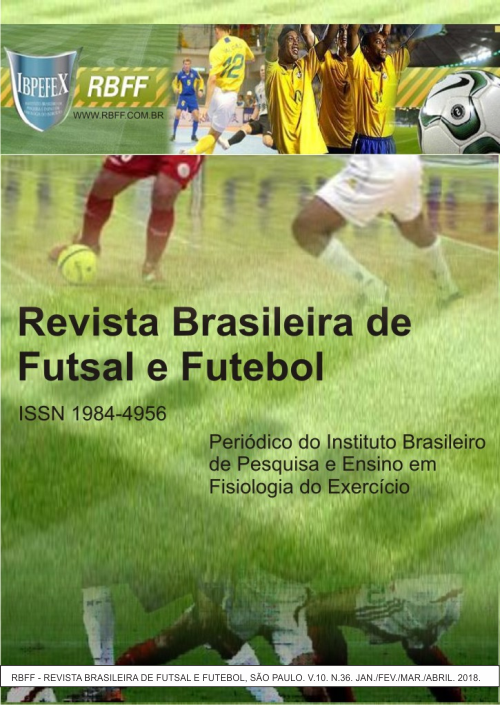Qualitative index of victories and defeats: an analyze of feminine world cup FIFATM 2015
Abstract
This article aims to compare technical indicators percentage of possession (PB), ball-time game (TB), Shots (SH) and Shots on goal (SG) and bids that compromise the progress of the game, as fouls Commited (FC) and fouls Suffered (FS) between winning and losing teams Women's World Cup FIFATM 2015. To accomplish this goal, were collected on the official site of the entity analyzes of 52 matches, dropping 12 matches that ended tied in normal time. As for the statistics, we used the Student Paread Test with significance level of p <0.05. From this analysis, it is concluded that winning teams had higher indicators in PB (54.8 ± 6.8), TB (28.3 ± 4.9), SH (15.3 ± 7.3) and SG (6.0 ± 4.0). We conclude that the victorious teams dominated the indicators related to technical quality, and these are the explanatory factors for competitive success.
References
-Anderson, C.; Sally, D. Os números do jogo. São Paulo. Paralela. 2013.
-Cabral, L.F.L. Análise das Seleções brasileira e alemã de futebol na Copa do Mundo de 2014. TCC. Universidade Federal do Rio Grande do Sul. Porto Alegre, 2015.
-Castellano, J.; Casamichana, D.; Lago, C. The Use of Match Statistics that Discriminate Between Successful and Unsuccessful Soccer Teams. Journal of Human Kinetics. Vol. 31. p. 139-147. 2012.
-Daolio, J. As Contradições do Futebol Brasileiro. Lecturas: Educación Física y Deportes Ano 3. Num. 10. 1998.
-Drusbscky, R. Universo tático do futebol: escola brasileira. 2ªedição. Belo Horizonte.Health.2014.
-FIFA. Regras de jogo. 2013. Disponível em <http://www.fifa.com>. Acesso em 20/10/2016.
-Garganta, J. Modelação táctica do jogo de Futebol: Estudo da organização da fase ofensiva em equipas de alto rendimento. 1997. Tese de Doutorado. Faculdade de Ciências do Desporto e Educação Física, Universidade do Porto. Porto. 1997.
-Henriques, P. O Treino da Tomada de Decisão do Árbitro de Futebol. Faculdade de Motricidade Humana. Lisboa. 2008.
-Lamas, F. L.; Borges, C. N. F. Reflexões Sobre o Número de Faltas no Futebol Brasileiro e sua Interferência na Dinâmica do Jogo. Revista Mineira de Educação Física. Vol. 13. Num. 2. p. 83-95. 2005.
-Leitão, R. A. A. Futebol –Análises qualitativas e quantitativas para verificação e modulação de padrões e sistemas complexos de jogo. Dissertação de Mestrado. Curso de Educação Física, Universidade Estadual de Campinas. Campinas. 2004.
-Mendes, A. Scouting, o futebol (re)nasce aqui. Lisboa. Chiado. 2016.
-Misuta, M. S. Rastreamento automático de trajetórias de jogadores de futebol por videogrametria: validação do método e análise dos resultados. Dissertação de Mestrado em Educação Física. Faculdade de Educação Física. Universidade Estadual de Campinas. Campinas, 2004.
-Peñas, C. L.; Ballesteros, J. L.; Dellal, A.; Gómez, M. Game-related statistics that discriminated winning, drawing and losing teams from the Spanish soccer league. Journal of Sports Science and Medicine. Vol. 9. p. 288-293. 2010.
-Peñas, C. L.; Ballesteros, J. L.; Rey, E. Differences in performance indicators between winning and losing teams in the UEFA Champions League. Journal of Human Kinetics. Vol. 27. p. 135-146. 2011.
-Quina, J. N. 59-Futebol: referências para a organização do jogo. 2001.
-Ramos Filho, L. A. O.; Alves, D. M. Análise do Scout individual da Equipe Profissional de Futebol do Londrina Esporte Clube no Campeonato Paranaense de 2003. Revista Treinamento Desportivo. Vol. 7. Num. 1. p. 62-67. 2006.
-Silva, S. A.; Silva, C. D.; Paoli, P. B.; Bottino, A. A.; Marins, J. C. B. Análise de correlação dos indicadores técnicos que determinam o desempenho das equipes no Campeonato Brasileiro de Futebol. Revista Brasileira de Futebol. Vol. 2. Num. 2. p. 40-45. 2009.
-Tempone, G.M.T; Silva, C.D. Análise de indicadores quantitativos de vitórias e derrotas na Copa do Mundo FIFA 2010. Revista Brasileira de Futebol. Vol. 5. Num. 1. p. 42-46. 2012.
-Ziskind, F. S. Scout digital no futebol feminino. TCC. Faculdade de Educação Física, Universidade Estadual de Campinas. Campinas. 2006.
Authors who publish in this journal agree to the following terms:
- Authors retain the copyright and grant the journal the right of first publication, with work simultaneously licensed under the Creative Commons Attribution License BY-NC which allows the sharing of the work with acknowledgment of the authorship of the work and initial publication in this journal.
- Authors are authorized to enter into additional contracts separately for non-exclusive distribution of the version of the work published in this journal (eg, publishing in institutional repository or book chapter), with acknowledgment of authorship and initial publication in this journal.
- Authors are allowed and encouraged to post and distribute their work online (eg, in institutional repositories or on their personal page) at any point before or during the editorial process, as this can bring about productive change as well as increase impact and impact. citation of published work (See The Effect of Free Access).





